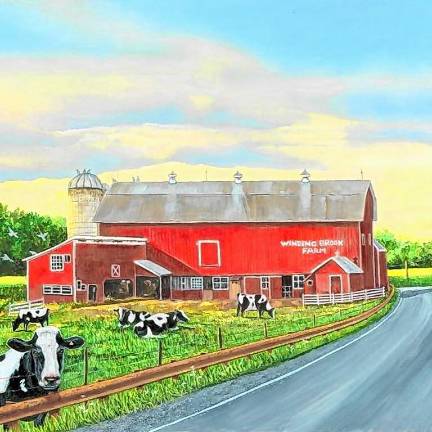
Today let’s look at another visual interpretation from the book “New Jersey: A Guide to Its Past and Present,” which was published in 1939 as part of the Federal Writers’ Project.
This program, by the way, was a part of President Franklin Roosevelt’s New Deal, providing jobs for writers during the Great Depression. It was under the Works Progress Administration.
Some more background here. Part of the road we will envision was Route 8. Much of the road we know today as Route 23 was known as Route 8 before 1927 and existed from 1916.
Route 8 went from Montclair north to where Route 287 meets New York state at Unionville, N.Y., today.
Pre-1927, Route 8 ran from Montclair north to the New York border near Unionville. It didn’t go over High Point. Interestingly, a “spur” of Route 8 went from Franklin Furnace west through Monroe, Lafayette and Branchville, ending at the Dingmans Ferry, Pa.
So, the guide takes us south of Sussex Borough, where we will listen to the writer’s journey:
“Largely unspoiled by signs, except those advertising such rural necessities as well drilling, State 8N has been chosen as a good medium for the small orange and black signs that describe, in doggerel spread over a series of five panels, the romantic conquests and other joys attained by users of a brushless shaving cream. One local resident, making the ultimate protest against these unscannable jingles, has nailed over a fifth sign (which revealed the brand name) a piece of cardboard bearing the neatly lettered word “NUTS.” ” (See more about Burma-Shave below.)
“At 6.3 m. the highway crosses a branch of the Erie R.R. at a grade and descends into the unimposing outskirts of Sussex. Nondescript frame houses perch on a hill slope, each with a small frame outhouse in the rear.”
“PELLETTOWN, 12.2 m. (420 alt.), is little more than a general store (R) and a railroad station at the crossing of the Lehigh and New England R.R. and Papakating Creek. At 13.9 m. is (R) WINDING BROOK FARM, named for a tortuous stream that can water more cows per airline yard of length than any other brook in this part of the State. In this area and elsewhere along the route, weathered, brownish slate formations are exposed in highway cuts. Known to geologists as the Martinsburg shale, the rock has hardened and become slate through metamorphism. Outcroppings continue into eastern Pennsylvania, where the rock is extensively quarried for commercial use. ROSS CORNER, 15.9 m. (500 alt)”
Note 1: The reference to Winding Brook Farm describes the farm with that beloved red barn. As recently as a few years ago, it was still there but sadly now is gone.
Note 2: It is revealing how 100 years ago, the same traveled way went more to Dingmans Ferry, indicative of the path, from the early 1800s, that took American settlers to the Midwest as our nation grew. Route 8 followed in part the Newark-Pompton Turnpike and then the Hamburg Turnpike that were made in the early 1800s.
Note 3: Burma-Shave was introduced in 1925 by the Burma-Vita company in Minneapolis owned by Clinton Odell. The company’s original product was a liniment made of ingredients described as having come “from the Malay Peninsula and Burma” (which gave it the name). Many of us recall those Burma-Shave signs that have faded away since the late 1960s. I personally think I recall a set in the Pellettown area.
For nostalgia’s sake, here are a few of those expressions on the signage:
• Every shaver / Now can snore / Six more minutes / Than before / By using / Burma-Shave
• Hardly a driver / Is now alive / Who passed / On hills / At 75 / Burma-Shave
• Past / Schoolhouses / Take it slow / Let the little / Shavers grow / Burma-Shave
• If you dislike / Big traffic fines / Slow down / Till you / Can read these signs / Burma-Shave
Times change, that’s for sure. It’s nice to look back and realize the contrasts as well as similarities to our life in northern New Jersey.
Bill Truran, Sussex County’s historian, may be contacted at billt1425@gmail.com